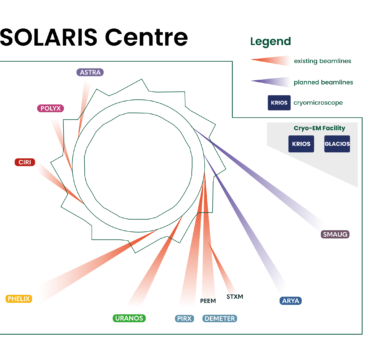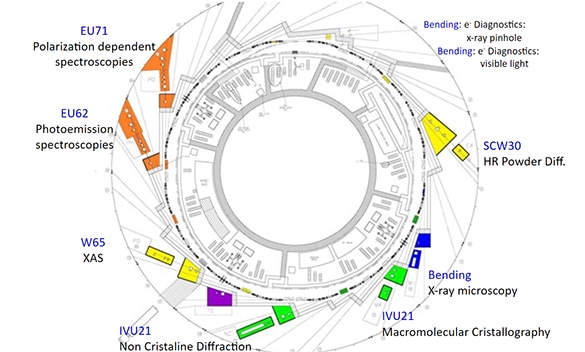Industrial research at synchrotron radiation facilities
Synchrotron is a large-scale particle accelerator, where an electron beam, travelling almost at the speed of light, is enclosed in a circular vacuum ring (storage ring) using powerful magnets which bend its trajectory. When the direction of motion of electrons is changed, they emit extremely bright radiation (synchrotron radiation), which is then used by scientists to perform complex experiments.
Synchrotron radiation is characterized by unique properties. In addition to its extreme intensity (tens of millions times higher then any laboratory source, or even the Sun), it covers a wide range of energies (from infrared, through UV/Vis to hard X-ray photons), is strongly collimated, can be polarized linearly, circularly or elliptically and has a distinct, femtosecond time structure. This means, that at the synchrotron radiation facilities, it is possible to perform experiments, which simply wouldn’t have been possible in the traditional laboratories. From the practical point of view, these properties also translate to higher quality experimental data (higher signal-to-noise ratio), faster and more precise results, and the ability to choose from a wide range of complimentary experimental techniques.
At every synchrotron, a storage ring is accompanied by a set of beamlines, focused on extracting different parts of the synchrotron radiation spectrum, best suited for the particular experimental techniques. Synchrotron SOLARIS currently operates five beamlines and a Cryo-EM facility. Synchrotron ALBA currently operates eight beamlines (plus additional diagnostic lines).
Research techniques available for industrial and academic users at Solaris include:
Spectroscopic methods
- XAS (X-ray absorption spectroscopy): ASTRA, DEMETER, PHELIX, PIRX
- XMCD/XMLD (X-ray magnetic circular/linear dichroism): DEMETER, PHELIX, PIRX
- PS (photoelectron spectroscopy): URANOS, PHELIX
- AES (auger electron spectroscopy): DEMETER, URANOS, PHELIX, PEEM, PIRX
Diffraction methods
- LEED (low energy electron diffraction): DEMETER, PIRX, URANOS, PHELIX
Microscopic methods
- PEEM (photoelectron emission microscopy): DEMETER
- STXM (scanning transmission x-ray microscopy): DEMETER
- Cryo-EM (Cryo – electron microscopy): Cryo-EM
Research techniques available at Alba include:
- IR (infrared) spectromicroscopy
- TXM (full-field transmission X-ray microscopy, enabling cryo nano-tomography)
- XRD (single-crystal and powder X-ray diffraction)
- SAXS (small-angle X-ray scattering)
- XAS (X-ray absorption spectroscopy) and XES (X-ray emission spectroscopy)
- XMD (X-ray magnetic dichroism)
- XRR (X-ray reflectivity)
- PEEM (photoelectron emission microscopy)
- NaPPs (near ambient pressure photoemission spectroscopy)
Both synchrotrons offer a range of different access options for industrial and academic users, including proprietary access, guaranteeing the confidentiality of the obtained results.
You can find more information about industrial research at SOLARIS here and at ALBA here.

